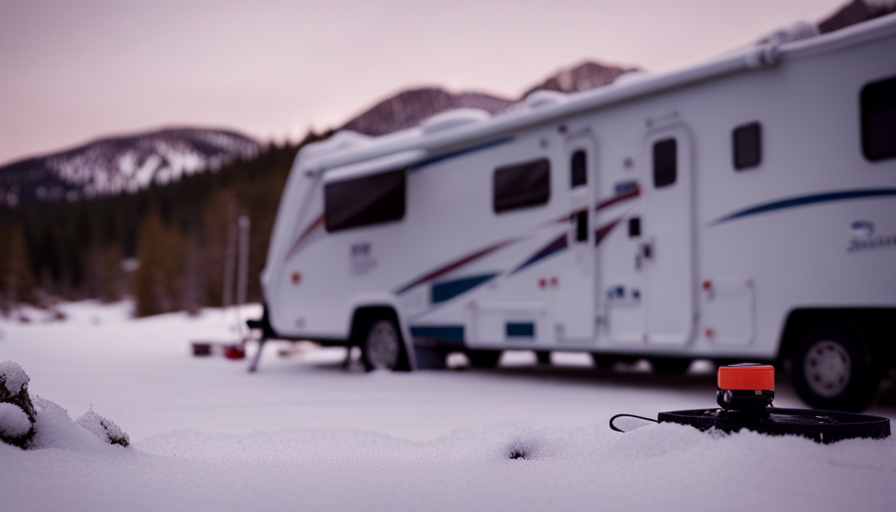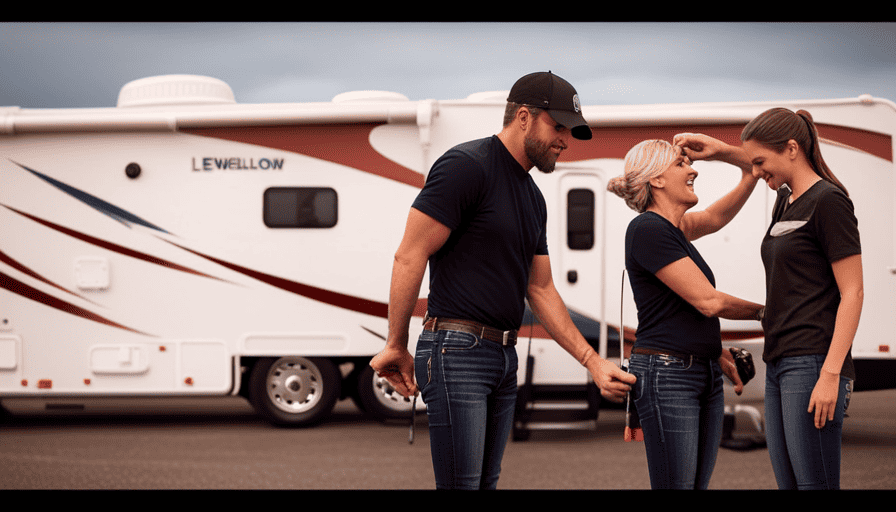It’s time to get ready and gear up because winter is approaching! If you’re planning on hunkering down in a camper during the cold months, don’t worry, we have all the essentials you’ll need.
In this article, we’ll show you how to winterize a camper to make it cozy and livable even when the temperatures drop.
When it comes to winterizing, it’s important to be as snug as a bug in a rug. We’ll guide you through insulating your camper’s windows and sealing any drafts or leaks, so you can keep that cold air at bay.
We’ll also teach you how to protect the underbelly of your camper with skirting and install a vent cover to prevent pesky condensation.
But staying warm isn’t just about insulation. We’ll share some tricks of the trade, like using heated mattress pads or blankets to keep the chill away.
And don’t forget about your water pipes! We’ll show you how to safeguard them from freezing and suggest using an insulated hose and heat tape for water hookup.
With our expert tips and a backup heating source, you’ll be able to enjoy a winter wonderland in your camper without turning into a popsicle.
So, let’s get started and make your camper a cozy retreat during those frosty months!
Key Takeaways
- Insulate windows using thermal or reflective window film and DIY curtains
- Seal drafts and leaks with caulking, weatherstripping tape, foam insulation, and door sweeps
- Use skirting, such as vinyl skirting or insulated foam board skirting, to protect the underbelly of the camper and aid in temperature control
- Take precautions to protect water pipes by insulating them, using insulated hoses and heat tape, and keeping propane tanks full and properly insulated.
Insulate Your Camper’s Windows
Are you ready to cozy up your camper for the winter? Let’s start by insulating those windows! As experienced campers, we know that the windows can be a major source of heat loss during the colder months.
Luckily, there are several window film options available that can help keep the cold air out and the warm air in. One popular option is the thermal window film, which creates a barrier against drafts and can significantly improve the insulation of your windows. Another option is the reflective window film, which not only insulates but also helps to block out harmful UV rays.
In addition to window films, DIY curtains can also provide an extra layer of insulation. Use thick, thermal curtains to cover your windows and keep the cold air at bay. You can even make your own curtains using insulating fabric or by adding thermal lining to your existing curtains.
Once you have insulated your camper’s windows, it’s time to seal any drafts or leaks. Stay tuned for our next section, where we will discuss how to identify and seal these problem areas. Let’s make sure your camper is warm and cozy throughout the winter!
Seal Any Drafts or Leaks
To ensure maximum insulation, it’s crucial to seal any drafts or leaks in your camper, as even a small gap can result in significant heat loss. Preventing cold air from entering your living space is essential when winterizing your camper. Here are some weatherstripping techniques that can help you seal those pesky drafts:
-
Caulking: Use silicone or acrylic caulk to seal any gaps or cracks around windows, doors, and vents. This will prevent cold air from seeping into your camper.
-
Weatherstripping tape: Apply weatherstripping tape around the edges of windows and doors to create a tight seal. This will help keep the heat in and the cold air out.
-
Foam insulation: Fill any larger gaps or holes with foam insulation. This will provide an additional layer of insulation and prevent drafts from entering your living area.
-
Door sweeps: Install door sweeps at the bottom of exterior doors to prevent cold air from coming in through the gap between the door and the floor.
By properly sealing your camper, you can keep the cold air out and the warm air in, ensuring a cozy and comfortable living space during the winter months.
As we move into the next section about using skirting to protect the underbelly, it’s important to consider all aspects of winterizing your camper.
Use Skirting to Protect the Underbelly
By using skirting, you can effectively shield the underbelly of your camper, providing an extra layer of protection against the harsh winter elements. Skirting is an essential step in winterizing your camper to live in during the colder months. Not only does it help to keep the cold air out, but it also aids in temperature control inside the camper.
When it comes to choosing the best materials for skirting, there are a few options to consider. One popular choice is vinyl skirting, which is durable, easy to install, and provides excellent insulation. Another option is insulated foam board skirting, which offers superior thermal protection. It is important to ensure that the skirting fits tightly around the base of the camper to prevent drafts and heat loss.
Using skirting for temperature control is crucial when living in a camper during winter. It helps to maintain a comfortable and consistent temperature inside, reducing the need for excessive heating. Additionally, skirting can prevent pipes and tanks from freezing, ensuring that you have a reliable water supply throughout the season.
Now, let’s move on to the next step of winterizing your camper: installing a vent cover to prevent condensation.
Install a Vent Cover to Prevent Condensation
Installing a vent cover is essential for preventing condensation and ensuring a cozy, moisture-free environment inside your camper during the chilly winter months. As experienced campers, we know that condensation can be a major issue when living in a camper during winter. When the warm air from cooking, showering, and breathing meets the cold surfaces of the camper, it can create moisture, leading to mold, mildew, and discomfort. By installing a vent cover, you can allow proper air circulation while also preventing cold air from entering.
To further enhance the insulation of your camper, consider installing roof insulation. This will help to keep the warm air inside and the cold air out, reducing the amount of condensation that forms. Additionally, using dehumidifiers can be highly beneficial in removing excess moisture from the air, keeping the humidity levels in check and preventing condensation from occurring.
Now that we’ve covered the importance of vent covers and insulation, let’s move on to the next step: using heated mattress pads or blankets.
Use Heated Mattress Pads or Blankets
Using heated mattress pads or blankets can provide an extra layer of warmth and comfort during the cold winter months in our camper. When the temperatures drop, it’s essential to have reliable sources of heat to keep us cozy inside.
Heated mattress pads are an excellent option as they can be placed directly on top of the mattress, providing warmth from underneath. These pads are equipped with adjustable temperature settings, allowing us to find the perfect level of heat for a good night’s sleep.
Electric blankets are another popular choice, offering warmth and comfort while lounging on the couch or sitting at the table. They come in various sizes and designs, ensuring there’s a suitable option for every camper. The convenience of these heated bedding options cannot be overstated, as they’re easy to use and offer instant warmth.
As we explore ways to stay warm in our camper, let’s now discuss the use of space heaters or portable radiators.
Use Space Heaters or Portable Radiators
Stay warm and cozy in your camper this winter by incorporating space heaters or portable radiators into your heating strategy. These energy-efficient heating options can provide targeted warmth to specific areas of your camper, helping you save on energy costs while staying comfortable.
Using space heaters or portable radiators in your camper requires some safety precautions. Here are a few tips to keep in mind:
- Always keep the heater at least three feet away from any flammable materials, such as curtains or bedding.
- Avoid using extension cords with space heaters as they can overheat and cause a fire hazard.
- Make sure to turn off the heater when you leave the camper or go to sleep.
By following these safety tips, you can enjoy the benefits of space heaters or portable radiators without worrying about potential risks.
Incorporating these energy-efficient heating options into your winterizing plan can help you create a warm and comfortable living space in your camper. Once you have your heating strategy in place, it’s important to also protect your water pipes from freezing.
Protect Water Pipes from Freezing
To ensure that your water pipes don’t freeze during the chilly months, imagine them as delicate veins that need insulation and warmth to prevent them from becoming brittle and bursting. Preventing frozen pipes is crucial when winterizing your camper for a comfortable living experience.
The first step is to insulate the pipes properly. Pipe insulation is an effective way to protect your water pipes from freezing temperatures. This foam or fiberglass wrap acts as a barrier, providing insulation and preventing heat loss. It helps maintain a consistent temperature inside the pipes, keeping them from freezing.
When choosing pipe insulation, make sure to select the appropriate size for your pipes. Measure the diameter of the pipes and choose insulation that fits snugly around them. Wrap the insulation around the pipes, covering them completely. Secure the insulation with tape or zip ties to ensure it stays in place.
Using pipe insulation is a simple yet effective way to prevent frozen pipes in your camper. By insulating your water pipes, you can enjoy a steady water supply throughout the winter months.
In the next section, we’ll discuss another method to protect your water hookup, which is using an insulated hose and heat tape. This ensures that your water supply remains uninterrupted, even in freezing temperatures.
Use Insulated Hose and Heat Tape for Water Hookup
For an uninterrupted water supply in freezing temperatures, try using an insulated hose and heat tape for your water hookup. An insulated hose is a great alternative to traditional hoses because it’s designed to withstand cold temperatures and prevent water from freezing inside. It’s made with layers of insulation that help maintain the water’s temperature, ensuring that it flows freely even in the coldest weather.
Additionally, an insulated hose is resistant to kinking and cracking, making it a durable option for winter camping.
Heat tape is another essential tool to keep your water hookup from freezing. It’s a flexible heating element that can be wrapped around the hose or water pipes. When plugged in, it generates heat that prevents the water from freezing inside the hose or pipes. This ensures a constant flow of water and eliminates the risk of burst pipes.
If you’re looking for an alternative to heat tape, consider using self-regulating heating cables. These cables automatically adjust their heat output based on the surrounding temperature, providing efficient and reliable freeze protection.
By using an insulated hose and heat tape or self-regulating heating cables, you can ensure a steady water supply in freezing temperatures.
Now, let’s move on to the next step of winterizing your camper: keeping propane tanks full and insulated.
Keep Propane Tanks Full and Insulated
Make sure your propane tanks are always full and properly insulated to keep them functioning efficiently, like a cozy winter coat that keeps you warm on a chilly day. Propane safety is crucial when winterizing your camper, as propane is the primary fuel source for heating and powering appliances.
Before the cold weather hits, it’s important to inspect your propane tanks for any signs of damage or leaks. If you notice any issues, it’s best to have a professional technician address them promptly.
To ensure your propane tanks stay in good condition throughout the winter, keep them full. This helps prevent condensation from forming inside the tanks, which can lead to corrosion. Additionally, insulating your propane tanks with specialized insulation blankets or foam sleeves can help maintain a consistent temperature and prevent freezing.
Winterizing camper appliances also involves checking and maintaining the propane lines and connections. Inspect the lines for any signs of wear or damage and replace them if necessary. It’s essential to follow the manufacturer’s instructions for your specific camper and appliances when it comes to propane safety and maintenance.
Having a backup heating source is crucial in case of propane supply issues or extreme weather conditions. We’ll discuss this further in the next section, where we explore alternative heating options for winterizing your camper.
Have a Backup Heating Source
Now that we’ve discussed the importance of keeping our propane tanks full and insulated, let’s move on to our next crucial step in winterizing a camper to live in: having a backup heating source.
While propane is a reliable fuel for heating, it’s always wise to be prepared for unexpected situations. One of the best ways to ensure a warm and cozy living space during the winter months is by investing in a backup generator. This handy device can power up alternative heating sources when needed, providing peace of mind and comfort.
In case of a power outage or if we run out of propane, the backup generator will kick in and keep us warm. When it comes to alternative fuel sources, there are a few options to consider. Wood-burning stoves or pellet stoves are popular choices, as they can efficiently heat up a camper and provide a cozy ambiance. Additionally, electric space heaters can be used if we have access to electricity.
Remember, staying warm is not just a matter of comfort, but also a matter of safety. By having a backup heating source in place, we can ensure that we stay cozy and protected throughout the winter season, no matter what challenges may arise.
Frequently Asked Questions
How can I prevent my camper’s windows from fogging up during the winter?
To prevent condensation and insulate camper windows during winter, we’ve found a few effective strategies.
First, installing thermal curtains or window insulation film can help regulate temperature and reduce moisture buildup.
Additionally, using a dehumidifier inside the camper can help remove excess moisture from the air.
Finally, applying a layer of insulating window film or using thermal window coverings can help minimize heat loss and keep windows clear of fog.
Is there a specific type of skirting that is best for protecting the underbelly of a camper?
The best materials for protecting the underbelly of a camper are sturdy and weather-resistant. Some popular options include aluminum, vinyl, and insulated skirting.
When it comes to installation, it’s important to ensure a tight fit to prevent drafts and ensure maximum insulation. Start by measuring the perimeter of your camper and cut the skirting accordingly. Use fasteners like screws or adhesive to secure the skirting in place.
What are some common areas where drafts and leaks can occur in a camper?
Common causes of condensation in a camper include poor insulation, lack of ventilation, and temperature differences inside and outside. To effectively seal windows and doors, use weatherstripping and caulk to fill any gaps.
Insulating curtains or window film can also help prevent drafts. Additionally, adding insulation to walls and floors can further reduce drafts and heat loss.
Regularly checking and maintaining seals and caulking can ensure a well-sealed camper, minimizing drafts and leaks.
Are there any precautions I should take when using space heaters or portable radiators in my camper?
When using space heaters or portable radiators in our camper during winter, there are some important precautions to keep in mind.
First, never leave them unattended and ensure they’re placed on a stable surface away from flammable materials.
Additionally, make sure to regularly check the cords for any signs of wear or damage.
To prevent windows from fogging up, try using moisture-absorbing products or opening a vent slightly for ventilation.
What steps should I take to ensure the propane tanks in my camper stay properly insulated during winter?
To ensure proper insulation of the propane tanks in our camper during winter, a few steps can be taken. Firstly, we should insulate the tanks with foam pipe insulation or specially designed propane tank covers. This helps to prevent freezing and maintain optimal performance.
Additionally, we should regularly check for any cracks or leaks in the tank or its fittings.
Lastly, using a dehumidifier can help prevent window fogging by reducing excess moisture in the camper.
Conclusion
So there you have it, our guide on how to winterize a camper to live in. By insulating windows, sealing drafts, using skirting, installing a vent cover, and using heated mattress pads or blankets, you can ensure a cozy and comfortable winter experience in your camper.
Additionally, protecting water pipes with insulation and using an insulated hose and heat tape for water hookup will prevent freezing. Don’t forget to keep propane tanks full and insulated, and have a backup heating source for added peace of mind.
Did you know that according to a study by the Recreation Vehicle Industry Association, over 10 million households in the United States own an RV or camper? So you’re not alone in your desire to live in a camper during the winter months.
Stay warm and enjoy your winter adventure!










